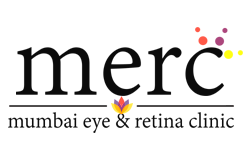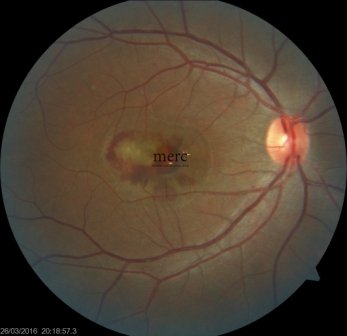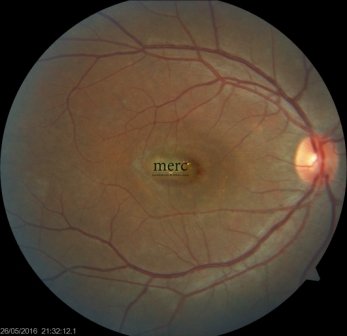What is age related macular degeneration or ARMD?
Age related macular degeneration is a condition in which there is progressive damage to the important parts of the retina, called the macula. It occurs due to the collection of waste material below the retina which would otherwise be cleared in a normal individual.
What are the stages/ types of ARMD?
As described above, ARMD starts with the collection of degraded material. This early stage is called Dry ARMD. Dry because there is no leakage of fluid or blood in the retina. As Dry ARMD worsens it may damage surrounding retina and structures below called GEOGRAPHIC ATROPHY.
Wet ARMD: it refers to the stage where there is leakage of blood or fluid in the retina. This happens due to the formation of new blood vessels called CNVM (choroidal neovascular membrane)
What are the symptoms of ARMD?
In early stages, there may not be any symptoms. It is therefore recommended that people aged 40 years or more especially with family history of Age Related Macular Degeneration have a routine eye check.
Common symptoms are:
- blurring of vision
- Inability to read fine prints of paper
- Objects appear irregular or lines appear wavy
- Black patch in the field of vision called "scotoma"
How is ARMD diagnosed? Will I need any investigations?
Age Related Macular Degeneration can be diagnosed by a retina specialist by clinical examination. However certain investigations are very important and your doctor may advise any one or all of the investigations mentioned below:
- OPTICAL COHERENCE TOMOGRAPHY (OCT): it is a technique to image the cross-sectional details of the retina. With our latest OCT, beautiful HD (high definition) images of the retina can be obtained so that we don't miss anything
- FFA: FUNDUS angiography is a test in which a dye is injected into the vein on the hand. The dye reaches the retina and pictures are taken with a specialised camera.
- ICG Angiography: it is similar to FFA but much more sophisticated and sensitive. Information not picked on FFA can be picked up with ICG.
Very few centres in Mumbai have an advanced ICG camera. We are happy that we at MERC are equipped with one of the best FFA/ICGA cameras in the industry from CARL ZEISS, GERMANY
How is Age Related Macular Degeneration treated?
Based on investigations Wet ARMD is categorised into different variants. Treatment varies depending on these variations.
Common treatments are:
- Intravitreal injections: Is the first line of treatment in the majority of patients. The medicine (drug) is directly injected into the gel of the eye with extremely thin needles. It is a painless procedure. Injecting medicines directly into the eye has a lot of advantages: its fast, effective, longer acting and fewer side effects on the rest of the body as the medicine remains within the eye. As time passes the concentration of the medicine in the eye drops and the disease restarts. Therefore multiple injections are required, typically once in a month. Some of the most commonly used injections are AVASTIN ( Bevacizumab ), LUCENTIS/ ACCENTRIX ( Ranibizumab ), EYLEA ( Aflibercept ) and ZALTRAP ( ZivAflibercept )
- Photodynamic Therapy (cold laser): It is a specialised treatment in which a light-sensitive dye Verteporfin (VISUDYNE) is injected into the blood via a slow intravenous infusion. The dye gets selectively concentrated in the choroidal new vessels (CNVM). A special laser is then focussed on this CNVM complex which activates the dye causing thrombosis/ closure of the CNVM complex. This treatment causes chemical reaction rather than heat. It is therefore called "cold laser"
- Thermal laser (Hot laser): it simply means burning the tissue by heat. In this, a thermal laser is used to destroy the CNVM complex. However, it also burns the normal retina thereby increasing chances of vision loss. Due to this risk, it is rarely used now.
- Macular/Sub Macular surgery: surgery is also required rarely in the treatment of ARMD. Very few indications like massive bleeding under the retina or large scar formation are some indications where surgery may be required. The results of surgery for Age Related Macular Degeneration are poor in general.
Can ARMD be prevented, arrested?
ARMD is a multifactorial disease. Various risk factors like genetics, race, dietary habits, smoking, exposure to UV light, deficiency of micronutrients and antioxidants have been identified. Very few of these factors can actually be controlled or manipulated to prevent/ arrest ARMD. Therefore ARMD can neither be prevented nor arrested completely. However certain studies such as the AGE RELATED EYE DISEASE STUDIES (AREDS 1 and 2 ) have shown the beneficial role of antioxidant and vitamin supplements. These can only slow down the disease in some patients but CANNOT prevent worsening completely.


